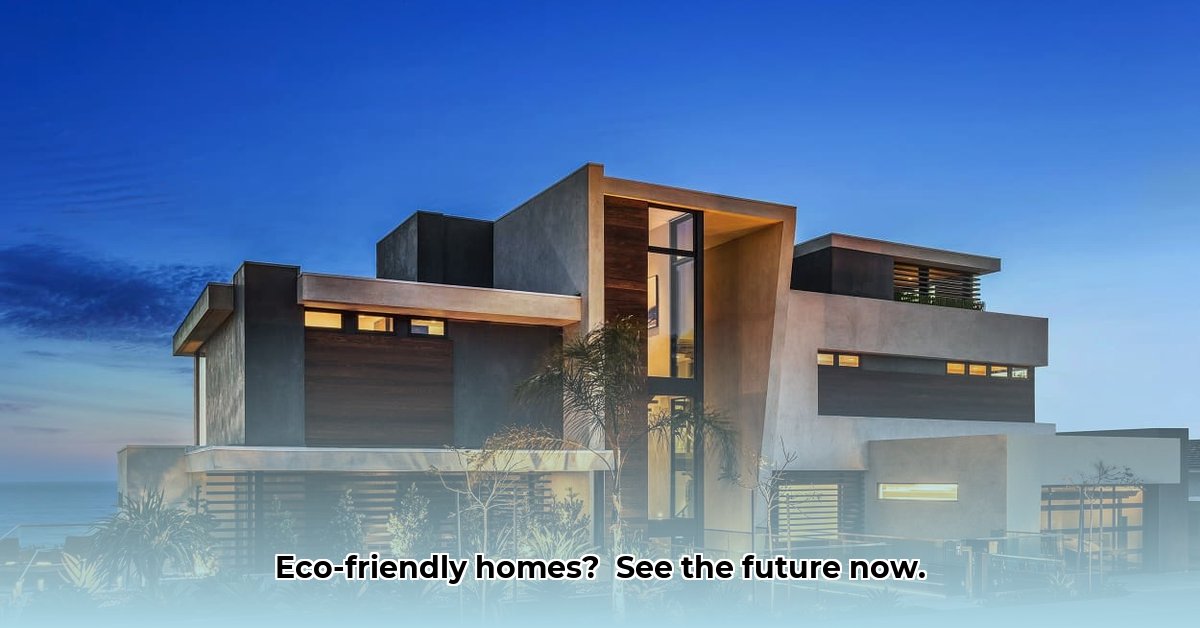Want a home that’s super cozy, eco-friendly, and practically pays for itself in the long run? Passive House design is the answer. This isn’t some futuristic idea; it’s a proven approach to building homes that are incredibly energy-efficient, comfortable, and good for the planet. We’ll walk you through everything you need to know, from the basic principles to the latest innovations and real-world examples from around the globe. Whether you’re a homeowner dreaming of a greener lifestyle, a builder looking to stay ahead of the curve, or an architect designing the homes of the future, this guide will show you how Passive House design can make a real difference – and how you can get involved. For more modern design ideas, check out these examples.
Modern Passive House Designs: Eco-Friendly Homes Now
Building a home is a big decision, impacting not only your lifestyle but also the planet. Modern passive house designs offer a compelling solution: homes that are incredibly energy-efficient, comfortable, and good for the environment. This isn’t just a trend; it’s a smarter way to build for the future and embrace energy efficiency.
Core Principles: The Science of Cozy and Energy Efficiency
Imagine a house that practically regulates its own temperature. That’s the magic of passive house design. It’s all about working with nature, not against it. The foundation rests on several key principles:
-
Super Insulation: Think of your house wrapped in a thick, high-tech blanket. This seriously cuts down on heat loss in winter and heat gain during scorching summers. We’re talking significantly improved insulation compared to standard building practices and reduced energy consumption.
-
Airtight Construction: Leaky homes waste energy like crazy. Passive house design prioritizes airtightness – creating a home as sealed as a thermos. This prevents drafts and keeps conditioned air exactly where it should be: inside, contributing to lower energy bills.
-
High-Performance Windows: These aren’t your grandma’s windows! Modern, multi-pane windows maximize natural light while minimizing energy loss. They act as highly efficient thermal barriers while letting the sun do its job of warming your home naturally, optimizing solar gains.
-
Smart Ventilation: You need fresh air, but not at the cost of energy efficiency. Mechanical ventilation systems with heat recovery bring in fresh air and exhaust stale air without letting your precious heated or cooled air escape. It’s like having a super-efficient lung for your entire house, enhancing indoor air quality.
These four elements work synergistically to create a home that’s naturally comfortable and dramatically reduces energy needs. What if every home could minimize its environmental impact?
Design Variations: A Style for Every Climate and Passive Design
The beauty of passive house design is its adaptability. It’s not some rigid, cookie-cutter approach. From sleek, modern apartments in bustling city centers to charming, rustic cabins nestled in the mountains, the principles remain the same, the aesthetic is completely customizable. Picture a sun-drenched Mediterranean villa or a cozy Scandinavian farmhouse – both could be built to passive house standards, each reflecting its unique environment and architectural style. The key is tailoring the specific details – insulation thickness, window placement, and building orientation – to the climate. This results in homes that are both energy-efficient and beautiful. Did you know, proper adaptation can lead to 75-90% energy savings?
Technological Advancements: The Future is Now with Building Materials
Passive house design isn’t stuck in the past; it’s constantly evolving. New materials, like aerogel insulation and vacuum insulated panels, are constantly being developed. Aerogel, derived from a gel in which the liquid component has been replaced with a gas, stands out for its exceptional thermal resistance and minimal thickness, addressing space constraints in retrofits. Vacuum insulated panels (VIPs) offer even greater thermal performance per unit thickness compared to traditional insulation materials. Innovative window technologies such as dynamic glazing, which adjusts its solar heat gain coefficient based on sunlight intensity, are also emerging Smart home systems are becoming increasingly integrated, automatically adjusting heating, cooling, and ventilation based on your habits and the weather. These advancements aren’t mere luxuries; they make passive houses even more energy-efficient and affordable. The progress in this field is exciting and creates a genuinely sustainable future.
Cost and Benefits: A Smart Investment in Energy Savings
The upfront cost of building a passive house is typically higher than a standard home, often ranging from 5% to 10% more due to the advanced materials and construction techniques required. However, the long-term savings are substantial. Think significantly lower energy bills, year after year. For example, homeowners can expect to see a reduction of up to 90% in heating and cooling energy consumption, translating to hundreds or even thousands of dollars saved annually. This long-term cost-effectiveness translates to a higher return on investment and increased property value. Beyond the financial benefits, consider the environmental advantages: a dramatically reduced carbon footprint, healthier indoor air quality, and a significant contribution to global sustainability efforts. It’s an investment in your comfort, your finances, and the health of the planet. Some experts believe the environmental and social benefits alone should outweigh purely financial considerations.
Certification and Standards: Quality Assurance and Building Performance
Passive House certification is a mark of excellence. Two primary certification bodies exist: the Passive House Institute (PHI) and the Passive House Institute US (PHIUS). PHI, based in Germany, is the original certifier and uses the Passivhaus standard, recognized globally for its rigorous energy performance criteria. PHIUS, adapted for the North American climate, is performance-based and considers regional climate variations for cost-effectiveness. Both assure that a building meets rigorous energy performance standards, undergoing independent verification to ensure the high quality of construction and design and the resulting energy efficiency. Different certification levels – Classic, Plus, and Premium – represent increasingly stringent energy targets. This certification offers peace of mind for homeowners and confirms that their home is truly a high-performance building, not simply marketed that way.
Actionable Steps: Building a Better Future for Sustainable Buildings
Passive house design isn’t just for architects and builders; it involves everyone. Here’s how different stakeholders can contribute:
| Stakeholder | Short-Term Actions | Long-Term Actions |
|---|---|---|
| Homeowners/Builders | Research local incentives, consult Passive House certified professionals. | Invest in certified construction, monitor energy consumption, and consider future upgrades. |
| Architects/Engineers | Participate in Passive House training, utilize appropriate design software. | Stay current with evolving standards and technologies. Strive to achieve net zero carbon design. |
| Governments/Policy Makers | Offer financial incentives, update building codes to reflect best practices. | Support research and development in sustainable building materials and passive house strategies. |
| Material Suppliers | Ensure materials meet Passive House standards; improve sustainability. | Develop innovative, cost-effective, and environmentally friendly materials. |
The shift towards passive house design is a movement towards a sustainable future. These homes represent a smarter, more responsible approach to construction, combining comfort, energy efficiency, and environmental consciousness. They are not just houses; they’re a testament to ingenuity, innovation, and a commitment to a greener tomorrow. The ongoing research and development in this field suggest even more efficient and cost-effective passive house solutions will emerge in the years to come.
How to retrofit existing homes for Passive House certification
Key Takeaways:
- Achieving significant energy savings (75-90%) is possible through EnerPHit retrofits.
- While initial costs are higher, long-term savings and increased property value offset the investment.
- A phased approach allows for manageable financial planning.
- Success relies on meticulous planning and attention to detail in insulation, airtightness, and component selection.
- Local regulations and skilled professionals play crucial roles in project feasibility.
Understanding Passive House Principles in Retrofits for Homeowners
Want a home that’s both comfortable and eco-friendly? How to retrofit existing homes for Passive House certification is the key. Passive House design is all about maximizing energy efficiency. Think of it like wrapping your house in a cozy, high-tech blanket. This involves several key elements:
- Superior Insulation: Imagine a thick, insulating layer protecting your home from harsh weather. This dramatically reduces heating and cooling needs. Options include adding external insulation, cavity wall insulation (if applicable), and upgrading attic insulation to meet recommended R-values.
- Airtight Construction: Preventing drafts is crucial. Think of sealing up all the tiny holes and cracks like caulking every gap to keep heat inside during winter. Specific strategies include sealing windows and doors, applying airtight membranes to walls, and sealing penetrations for pipes and wiring.
- High-Performance Windows: Modern windows are energy marvels, acting as effective barriers against heat loss. It’s like having super-insulated glass. Look for windows with low U-values (measuring heat transfer) and high solar heat gain coefficients (SHGC) to optimize energy performance. Triple-paned windows with gas fills are often recommended.
- Mechanical Ventilation with Heat Recovery (MVHR): This system provides fresh air while recovering heat from outgoing air, ensuring consistent comfort without energy waste. MVHR systems extract stale air from bathrooms and kitchens, recover the heat, and use it to pre-heat fresh air entering living spaces.
Diverse Design Adaptations in Retrofits for Building Professionals
Retrofitting existing homes for Passive House standards isn’t a one-size-fits-all solution. It adapts to various architectural styles and climates. Think
- Glass Tile Shower Ideas to Create a Stunning Bathroom Space - December 7, 2025
- Glass Wall Tile Ideas for Kitchens and Bathrooms - December 6, 2025
- Glass Tile Bathroom: Create a Beautiful, Easy-Clean Space - December 5, 2025










